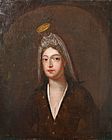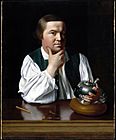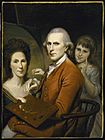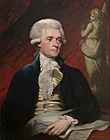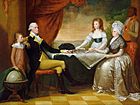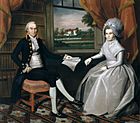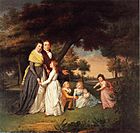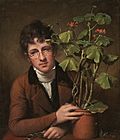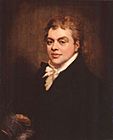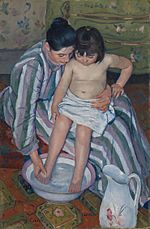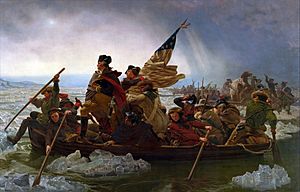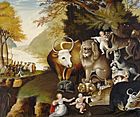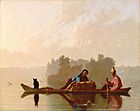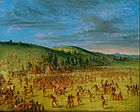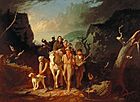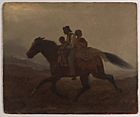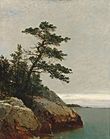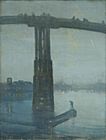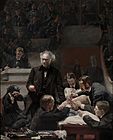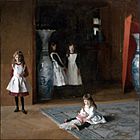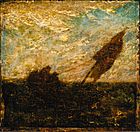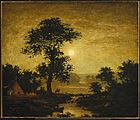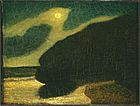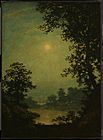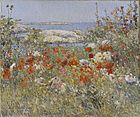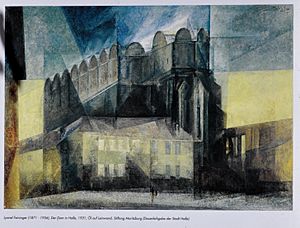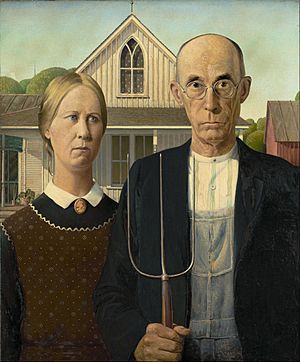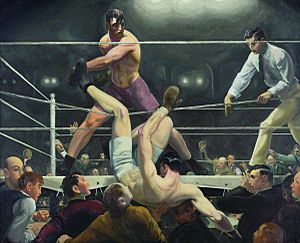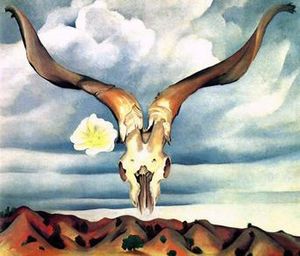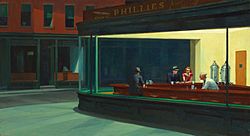Visual arts of the United States facts for kids

American art is visual art made in the United States or by artists from the U.S. Before European settlers arrived, many different Native American groups had their own rich art traditions. In areas colonized by Spain, Spanish Colonial architecture and related art styles quickly appeared.
Early art on the East Coast often came from European artists. John White (1540-c. 1593) was one of the first. In the late 1700s and early 1800s, artists mostly painted portraits and some landscapes. Their style was similar to English painting.
Later in the 1700s, two U.S. artists, Benjamin West and John Singleton Copley, became very successful painters in London. They focused on "history painting," which was considered the most important type of art then. This showed that American artists were becoming a strong force in Western art. Artists who stayed in America also became very skilled.
In the early 1800s, places to train artists began to open. Around 1820, the Hudson River School started creating Romantic landscape paintings. These paintings were unique and captured the huge size of U.S. landscapes. The American Revolution also created a need for art that showed patriotism, especially history paintings. Other artists recorded life in the frontier areas. At the same time, the American craft movement began in rural U.S. as a response to the Industrial Revolution.
After 1850, European-style art became popular. As Americans became wealthier, more European art, both new and old, came to the U.S. This trend continues today. Museums were built to show off these collections. New art ideas from Europe came to the U.S. through shows in New York City, like the Armory Show in 1913. After World War II, New York became the center of the art world instead of Paris. Since then, many U.S. art movements have shaped Modern and Postmodern art. Today, art in the United States includes a huge variety of styles.
Contents
Early American Art (1500s-1700s)
One of the first painters to visit British America was John White (c. 1540 – c. 1606). He made important watercolor drawings of Native American life on the East Coast. These drawings are now in the British Museum. In the early colonial days, most artists trained in Western styles were army or navy officers. Their training included sketching landscapes.
Eventually, English settlements grew large enough to support professional artists. Most of these were portrait painters, and many learned on their own. John Smybert (1688–1751) was a trained artist from London who moved to America in 1728. He became a portrait painter and print seller in Boston. His friend Peter Pelham was also a painter and printmaker. Both needed other jobs to make enough money. Meanwhile, in the Spanish territories that would later become part of America, most art was religious. It was often in the late Baroque style and created by local artists. Native American cultures also continued to make art in their own ways.
Art in the 1700s
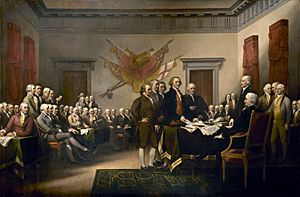
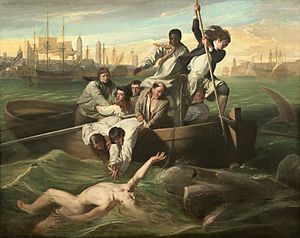
After the Declaration of Independence in 1776, the new nation needed to show its history. Art became a way to do this. Most early American art from the late 1700s to early 1800s included history paintings and many portraits. Like in colonial times, many portrait painters learned on their own. Famous examples include Joseph Badger, John Brewster Jr., and William Jennys.
American artists generally copied the style of British art. They learned from prints and paintings by English-trained artists like John Smibert and John Wollaston. Robert Feke (1707–1752), an untrained painter, developed a skilled style based on Smibert's work. Charles Willson Peale painted portraits of many important figures from the American Revolution. Peale's younger brother James Peale and six of his nieces and sons were also artists. These included Anna Claypoole Peale, Sarah Miriam Peale, Raphaelle Peale, Rembrandt Peale, Rubens Peale and Titian Peale.
Painters like Gilbert Stuart created portraits of the new government officials. His portrait of George Washington became very famous and was used on stamps. John Singleton Copley painted important portraits for the wealthy merchant class. One famous work is his portrait of Paul Revere (c. 1768–1770). His most famous painting, Watson and the Shark (1778), shows a dramatic scene. Benjamin West painted portraits and history paintings, including scenes from the French and Indian War. Many American artists studied with West in London. These included Washington Allston, Ralph Earl, James Earl, Samuel Morse, Charles Willson Peale, Rembrandt Peale, Gilbert Stuart, John Trumbull, Mather Brown, Edward Savage and Thomas Sully. John Trumbull painted large battle scenes from the Revolutionary War.
When landscapes were painted, it was often to show how much land someone owned. Or, they were used as a nice background for a portrait.
Famous Works by Early American Artists
-
John Singleton Copley, Paul Revere, c. 1768–1770, Museum of Fine Arts, Boston
-
Benjamin West, The Treaty of Penn with the Indians, 1771–72, Pennsylvania Academy of the Fine Arts
-
Gilbert Stuart, The Skater, 1782, National Gallery of Art, Washington, D.C.
-
Charles Willson Peale, Self-portrait, c. 1782–1785, Museum of Fine Arts, Houston
-
John Trumbull, The Death of General Montgomery in the Attack on Quebec, December 31, 1775, 1786, Yale University Art Gallery
-
Mather Brown, Portrait of Thomas Jefferson, 1786, National Portrait Gallery, Washington, D.C.
-
Edward Savage, The Washington Family 1789–1796, National Gallery of Art, Washington, D.C.
-
Ralph Earl, Portrait of Oliver Ellsworth and Abigail Wolcott Ellsworth, 1792, Wadsworth Atheneum
-
James Peale, The Artist and His Family, 1795. Pennsylvania Academy of the Fine Arts
-
John Brewster Jr., Mother with Son (Lucy Knapp Mygatt and Son, George, of Danbury, Connecticut), 1799
-
Rembrandt Peale, Rubens Peale With a Geranium, 1801, National Gallery of Art, Washington, D.C.
-
Washington Allston, Moonlit Landscape, 1809, Museum of Fine Arts, Boston, Massachusetts
-
Mather Brown, Self-portrait, c. 1812, American Antiquarian Society, Worcester, Massachusetts
-
Benjamin West, Benjamin Franklin Drawing Electricity from the Sky, c. 1816, Philadelphia Museum of Art
-
Thomas Sully, The Passage of the Delaware, 1819, Museum of Fine Arts, Boston
Art in the 1800s
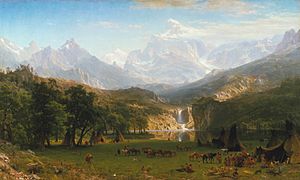
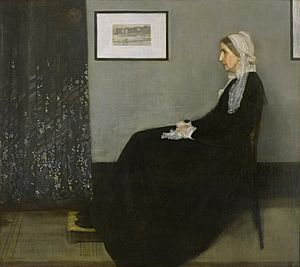
The first well-known U.S. painting style, the Hudson River School, began around 1820. Thomas Cole started this movement, which included artists like Albert Bierstadt, Frederic Edwin Church, and Thomas Doughty. This art style grew when artists realized America had unique landscapes to paint. The movement showed the amazing beauty of the frontier as people moved west.
The direct and simple style of the Hudson River painters influenced later artists. These included John Kensett and the Luminists. It also influenced George Inness and the tonalists, like Albert Pinkham Ryder and Ralph Albert Blakelock. Winslow Homer (1836–1910) painted rural America, focusing on the sea, mountains, and the people living there.
Robert S. Duncanson, a Hudson River School landscape painter, was one of the first important African American painters. John James Audubon, who studied birds, was a key naturalist artist. His main work, The Birds of America (1827–1839), is considered one of the best bird art collections ever. Edward Hicks was a U.S. folk painter and a respected minister of the Society of Friends (Quakers). He became a Quaker icon because of his paintings.
Paintings of the Great West also became a special type of art. Many of these showed the vast size of the land and the cultures of the native people. George Catlin tried to show the West and its people as truly as possible. Later, Frederic Remington, Charles M. Russell, and photographer Edward S. Curtis recorded the U.S. Western heritage through their art.
History painting was less popular in U.S. art during the 1800s. However, Washington Crossing the Delaware, painted by German-born Emanuel Leutze, is one of the most famous U.S. paintings. The historical and military paintings of William B. T. Trego were widely shared after he died.
Portrait painters in the U.S. in the 1800s included artists who learned on their own, like Ammi Phillips. There were also painters trained in Europe, such as Thomas Sully and G.P.A. Healy. Thomas Eakins (1844–1916) painted middle-class city life. He was a very honest realist, which meant he wasn't very popular during his lifetime. Today, he is seen as one of the most important U.S. artists. One of his students was Henry Ossawa Tanner, the first African-American painter to gain international fame.
A style of trompe-l'œil (trick the eye) still-life painting developed, mainly in Philadelphia. Artists like Raphaelle Peale (from the Peale family), William Michael Harnett, and John F. Peto were part of this.
Hiram Powers, the most successful U.S. sculptor of his time, moved to Europe. He spent the rest of his life there, creating classic statues of women. Several important American painters also lived much of their lives in Europe. These included Mary Cassatt, James McNeill Whistler, and John Singer Sargent. All of them were influenced by French Impressionism. Theodore Robinson visited France in 1887, became friends with Claude Monet, and was one of the first U.S. painters to use the new Impressionist style. In the late 1800s, American Impressionism, practiced by artists like Childe Hassam and Frank W. Benson, became a popular style.
Famous 19th-Century Works
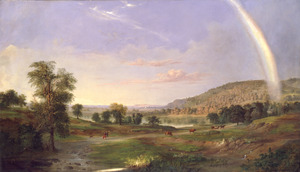
-
Edward Hicks, Peaceable Kingdom, c. 1834, National Gallery of Art
-
John J. Audubon, Washington Sea Eagle, c. 1836–1839, Smithsonian American Art Museum
-
George Catlin, An Indian Ball-Play c. 1846–1850, Smithsonian American Art Museum
-
George Caleb Bingham, Daniel Boone Escorting Settlers through the Cumberland Gap, 1851–52
-
Eastman Johnson, A Ride for Liberty – The Fugitive Slaves, oil on paperboard, ca. 1862, Brooklyn Museum
-
Frederic Edwin Church, Aurora Borealis, 1865, Smithsonian American Art Museum, Washington, D.C.
-
George Inness, Lake Albano, 1869. The Phillips Collection
-
John Kensett, The Old Pine, Darien, Connecticut, c. 1872, Metropolitan Museum of Art, New York City
-
James Abbott McNeill Whistler, Nocturne: Blue and Gold - Old Battersea Bridge (1872), Tate Britain, London, England
-
Thomas Eakins, The Gross Clinic, 1875, Philadelphia Museum of Art and the Pennsylvania Academy of the Fine Arts
-
John Singer Sargent, The Daughters of Edward Darley Boit, 1882, Museum of Fine Arts, Boston
-
Albert Pinkham Ryder, The Waste of Waters is Their Field, early 1880s, Brooklyn Museum
-
Ralph Albert Blakelock, Moonlight, 1885, Brooklyn Museum
-
Albert Pinkham Ryder, Seacoast in Moonlight, 1890, the The Phillips Collection, Washington, D.C.
-
Ralph Albert Blakelock, Moonlight Sonata, 1889–1892, Museum of Fine Arts, Boston
-
Childe Hassam, Celia Thaxter's Garden, 1890, Metropolitan Museum of Art, New York City
-
Frederic Remington, Aiding a Comrade, 1890, Museum of Fine Arts, Houston
-
Charles M. Russell, The Buffalo Hunt, 1899, Amon Carter Museum of American Art
-
Winslow Homer, The Gulf Stream, 1899, oil on canvas, Metropolitan Museum of Art, New York City
Art in the 1900s
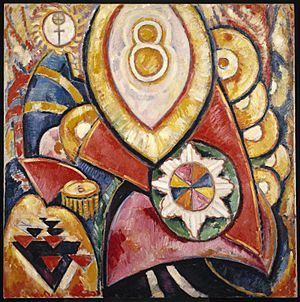
In the 1900s, American artists often challenged old traditions. Robert Henri (1865–1929) led the Ashcan School of painting. This group showed the gritty, everyday life of the city.
American Realism became a new direction for U.S. artists around 1900. Ashcan painters like George Bellows, Everett Shinn, George Benjamin Luks, William Glackens, and John Sloan created art that focused on social issues. The photographer Alfred Stieglitz (1864–1946) helped photography become a respected art form.
Soon, modernists from Europe arrived, bringing new styles like cubism and abstract painting. Stieglitz promoted these artists at his 291 Gallery in New York City. Important early American modernist painters included John Marin, Marsden Hartley, Georgia O'Keeffe, and Stuart Davis. Early modernist sculptors were William Zorach, Elie Nadelman, and Paul Manship.
After World War I, many American artists turned away from European modern art. Instead, they chose different styles of realism to show American city and country scenes. Grant Wood, Reginald Marsh, and Charles Sheeler are examples of realists. Sheeler, Charles Demuth, and Ralston Crawford were called Precisionists. They painted machines and buildings with sharp, clear lines. Edward Hopper developed his own realist style. He focused on light and form, avoiding obvious social messages.
Art of the American Southwest
After World War I, the Santa Fe Railroad made it easier to travel across the American West. New artist communities grew around Santa Fe and Taos. Artists there mostly painted the native people and landscapes of the Southwest.
Images of the Southwest became popular for advertising. The Santa Fe Railroad used them to encourage people to move west and enjoy the "untouched landscapes." Walter Ufer, Bert Geer Phillips, E. Irving Couse, William Henry Jackson, Marsden Hartley, Andrew Dasburg, and Georgia O'Keeffe were some of the most active artists in the Southwest. Georgia O'Keeffe is famous for her paintings of flowers, bones, and New Mexico landscapes, like Ram's Head White Hollyhock and Little Hills. O'Keeffe visited the Southwest in 1929 and moved there permanently in 1949. She lived and painted there until she died in 1986.
Harlem Renaissance (1920s-1930s)
The Harlem Renaissance was another important time for American art. In the 1920s and 1930s, a new group of educated African-American men and women emerged. They supported literary groups and art shows to fight against racist ideas. This movement showed the many talents within African-American communities. It included artists from all over America, but its center was in Harlem. The work of Harlem painter and graphic artist Aaron Douglas and photographer James VanDerZee became symbols of the movement. Other artists linked to the Harlem Renaissance include Romare Bearden, Jacob Lawrence, Charles Alston, Augusta Savage, Archibald Motley, Lois Mailou Jones, Palmer Hayden and Sargent Johnson.
New Deal Art (1930s)
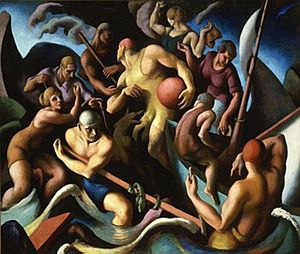
During the Great Depression, President Roosevelt's New Deal created public art programs. These programs gave work to artists and decorated public buildings, often with American themes. The first project, the Public Works of Art Project (PWAP), started after unemployed artists asked for help. The PWAP lasted less than a year but created nearly 15,000 artworks. It was followed by the Federal Art Project of the Works Progress Administration (FAP/WPA) in 1935. This program funded many well-known American artists.
The style of much WPA public art was influenced by Diego Rivera and other Mexican mural painters. Several art movements began during the Great Depression. These included American scene painting, Regionalism, and Social Realism. Thomas Hart Benton, John Steuart Curry, Grant Wood, and Ben Shahn were some of the most famous artists from this time.
Not all artists from this period were Regionalists or Social Realists. Milton Avery's paintings, which were almost abstract, influenced younger artists who would become Abstract Expressionists. Joseph Cornell, inspired by Surrealism, made box art using found objects and collage.
Abstract Expressionism
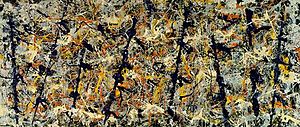
After World War II, a group of New York artists started the first American art movement to become famous worldwide: abstract expressionism. This term means using abstract art to show feelings and emotions from inside the artist.
The first group of abstract expressionists included Jackson Pollock, Willem de Kooning, Mark Rothko, Franz Kline, and Robert Motherwell. Many other important artists like Lee Krasner and Alexander Calder were also part of this period.
These artists had different styles, but critics found common ideas. Many were part of the New York School in the 1940s and 1950s. They were influenced by Cubist and Surrealist art from Europe. Most of them stopped painting real objects. Instead, they tried to create art using instinct and spontaneous arrangements of lines, shapes, and colors. Abstract Expressionism is known for two main things: the large size of the canvases (inspired by Mexican murals and WPA art) and the strong, unusual use of brushstrokes and paint. Artists experimented with new ways to apply paint.
Color Field Painting
Color Field painting focused on strong colors and large, open areas of paint. Artists like Ad Reinhardt, Adolph Gottlieb, Mark Rothko, and Barnett Newman were known for this. Another style was Action Painting. This involved spontaneous reactions, powerful brushstrokes, and paint being dripped or splashed. Jackson Pollock is a famous Action Painter. His way of throwing and dripping paint from a stick or pouring it from a can changed how painting was done.
Willem de Kooning once said about Pollock, "he broke the ice for the rest of us." Abstract Expressionism was a turning point for American art. In the 1940s and 1950s, the art world's attention shifted from Paris to New York.
Color Field painting continued into the 1960s. Artists like Morris Louis, Jules Olitski, and Helen Frankenthaler created paintings with simple repetitions, stripes, and large, flat areas of color.
After Abstract Expressionism
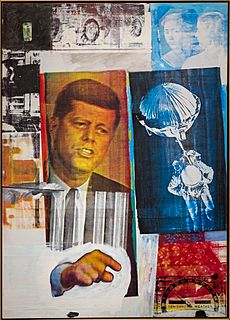

In the 1950s, abstract painting in America developed into new movements. These included Neo-Dada, Post painterly abstraction, Op Art, hard-edge painting, Minimal art, and Pop Art. As a reaction to abstract art, new styles with images appeared. These included Pop Art and later, in the 1970s, Neo-expressionism.
Lyrical Abstraction, the Fluxus movement, and Postminimalism tried to expand abstract painting and Minimalism. They focused on the process of making art, new materials, and new ways to express ideas. Postminimalism often used industrial materials, raw materials, and found objects. It also included installations and repeated patterns.
Lyrical Abstraction, Conceptual Art, Postminimalism, Earth Art, Video, Performance art, and Installation art expanded the world of Contemporary Art from the mid-1960s through the 1970s.
Lyrical Abstraction is similar to Color Field Painting and Abstract Expressionism. It uses paint texture and surface in a free way. It often features direct drawing, calligraphic lines, and effects from brushed, splattered, or poured paint.
During the 1960s, 1970s, and 1980s, many powerful painters created important works. These included Adolph Gottlieb, Lee Krasner, Robert Rauschenberg, Jasper Johns, Richard Diebenkorn, Ellsworth Kelly, Frank Stella, and Joan Mitchell. Younger artists like Brice Marden, Robert Mangold, and Sean Scully also made influential paintings.
Other Modern American Movements
The next generation of artists preferred a different kind of abstract art: mixed media works. Robert Rauschenberg (1925–2008) and Jasper Johns (1930- ) used photos, newspapers, and old objects in their art. Pop artists like Andy Warhol (1928–1987), Larry Rivers (1923–2002), and Roy Lichtenstein (1923–1997) copied everyday objects and images from American popular culture. They used things like Coca-Cola bottles, soup cans, and comic strips in their art.
Realism has always been popular in the United States, even with modern art trends. You can see realism in the city scenes of Edward Hopper, the country images of Andrew Wyeth, and the illustrations of Norman Rockwell. In some places, Abstract Expressionism didn't catch on. For example, in Chicago, the main art style was a strange, symbolic realism. This was seen in the work of the Chicago Imagists like Cosmo Campoli (1923–1997) and Jim Nutt (1938- ).
Contemporary Art into the 2000s
At the start of the 21st century, contemporary art in the United States continues in many different ways. There isn't one main style that defines the time. Instead, there's an "anything goes" attitude, with many different artistic paths being explored. Because of this, amazing and important artworks continue to be made in the United States, in a wide variety of styles.
Some continuing art styles today include Hard-edge painting, Geometric abstraction, Hyperrealism, Photorealism, Expressionism, Minimalism, Pop art, Abstract Expressionism, Graffiti, traditional figure painting, Landscape painting, and Portrait painting. These are just a few of the many directions painting is taking in the 21st century.
Notable American Artists
A few famous American artists include: Ansel Adams, John James Audubon, Milton Avery, Jean-Michel Basquiat, Thomas Hart Benton, Albert Bierstadt, Alexander Calder, Mary Cassatt, Frederic Edwin Church, Chuck Close, Thomas Cole, Edward S. Curtis, Richard Diebenkorn, Thomas Eakins, Lyonel Feininger, Helen Frankenthaler, Arshile Gorky, Keith Haring, Marsden Hartley, Hans Hofmann, Winslow Homer, Edward Hopper, Jasper Johns, Georgia O'Keeffe, Franz Kline, Willem de Kooning, Lee Krasner, Dorothea Lange, Roy Lichtenstein, Morris Louis, John Marin, Agnes Martin, Joan Mitchell, Grandma Moses, Robert Motherwell, Jackson Pollock, Man Ray, Robert Rauschenberg, Frederic Remington, Norman Rockwell, Mark Rothko, Albert Pinkham Ryder, John Singer Sargent, Cindy Sherman, David Smith, Frank Stella, Clyfford Still, Gilbert Stuart, Louis Comfort Tiffany, Cy Twombly, Andy Warhol, Grant Wood, and Andrew Wyeth.
See also
- Architecture of United States
- Art education in the United States
- Cinema of the United States
- History of painting
- Ledger art
- Modern art museums in the United States
- Museums of American art
- National Museum of the American Indian
- Native American museums in New York
- Photography in the United States of America
- Sculpture of the United States
- Synchromism
- Timeline of Native American art history
- Visual arts of Chicago
- Western painting
- Australian art
- Minimal art


